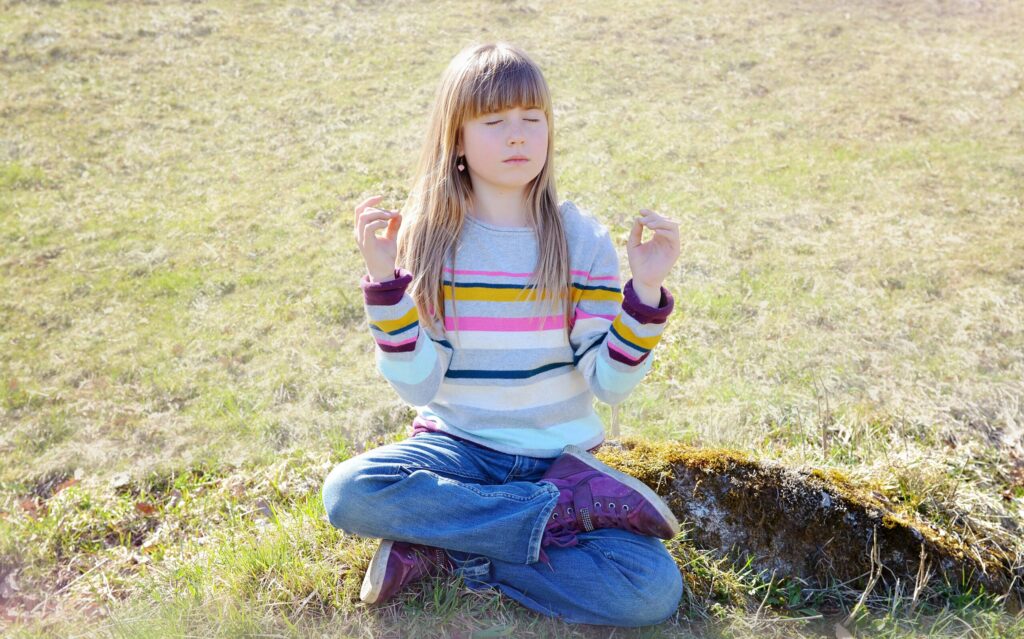Meditation is a simple tool to induce a state of calm, facilitate sleep, manage emotions, or enhance concentration. To experience its benefits, daily practice is recommended. Just a few minutes a day are enough.
Several children experience stress, emotions, or other challenges. Sometimes, it’s not easy to manage events, changes in their lives, or transitions. Children also experience stress. Practiced regularly, meditation tailored to each age can bring great benefits. It encourages connecting with one’s breath. It also encourages observing what is happening within oneself and in one’s environment. It allows for grounding in the present moment.
What are the benefits of meditation?
- It induces a state of calm.
- It helps to become aware of one’s emotions and manage them.
- It reduces stress and helps to manage it.
- It promotes sleep.
- It increases self-confidence.
- It allows energy to flow throughout the body.
- It enhances concentration.
At what age can a child meditate?
There are several meditation exercises adapted to the children and their age. A child can start meditating at the age of 2-3 years old. A few minutes are enough. At first, it’s possible that our child may only meditate for a few seconds. With practice, they will be able to meditate for longer. Respecting our child’s pace and needs is important. This will promote relaxation and interest. No set time should be imposed. Discovery and play related to meditation should be favored. Daily practice will bring benefits quickly and in the long term. Imagine if from childhood you had learned to meditate, manage your emotions, and handle your stress. Meditation is a precious and simple tool that we offer to our child. Meditating as a family is a wonderful activity to offer that is beneficial for everyone.
How to meditate?
The right posture: For meditation, a good posture is essential. It’s important that the body is comfortable to facilitate relaxation.
- Sitting on a chair
- Sitting cross-legged on a cushion
- Lying down on the floor on a yoga mat
- Lying down in bed
In a seated posture, a straight back is preferred. Both feet are placed on the ground. Shoulders are relaxed. The back can be supported for comfort.
How long to meditate?
Listening to your child’s rhythm is key, without pressure. Depending on their age and temperament, a child may meditate from a few seconds to a few minutes. Regular practice will gradually establish a longer meditation time. Daily practice will quickly bring about the benefits.
How to meditate?
Meditation Apps: Several meditation apps offer guided meditations for all ages, such as Petit Bambou, Headspace, and others to explore.
Videos: Many videos are available on YouTube, such as Les Arènes du Savoir, Enchanted Meditations, and others to discover.
Some meditation ideas: We can guide meditations for our child ourselves. The number of repetitions and the time allowed should be adjusted according to our child’s needs.
- Balloon Breathing: Inhale through the nose. Exhale through the nose. Now, inhale through the nose and expand your belly like a balloon. Upon exhaling, exhale through the nose, the balloon deflates, and so does your belly. (Hands can be placed on the belly to feel the balloon movements during inhalation and exhalation.)
- Listening to the surrounding sounds: Inhale through the nose. Exhale through the nose. Listen. What do you hear? (The purring cat, cars passing by on the street, dad cooking, little sister playing…)
- Candle Breathing: Imagine your birthday cake with candles in front of you. Inhale through the nose. Exhale through the mouth as if you were blowing out the candles on your cake. Inhale through the nose. Exhale through the mouth.
1, 2, 3 GO. Let’s meditate:
What a beautiful gift to offer time to meditate to your child, yourself, and your entire family!



